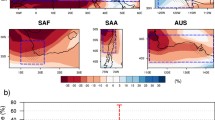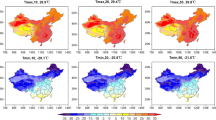Abstract
Given the severe impacts of hot summers on human and natural systems, we attempt to quantify future changes in extreme hot summer frequency in China using the Coupled Model Intercomparison Project Phase 5 (CMIP5) projections. Unlike previous studies focusing on fixed future time slices, we investigate the changes as a function of global mean temperature (GMT) rise. Analyses show that extreme hot summers (June-July-August mean temperature higher than 90 % quantile of 1971–2000 climatology) are projected to occur at least 80 % of the time across China with a GMT rise of 2 °C. The fraction of land area with extreme hot summers becoming the norm (median of future summer temperatures exceed the extreme) will increase from ~15 % with 0.5 °C of GMT rise to ~97 % with 2.5 °C GMT rise, which is much greater than for the global land surface as a whole. A distinct spatial pattern of the GMT rise threshold over which the local extreme hot summer first becomes the norm is revealed. When averaged over the country, the GMT rise threshold is 0.96 °C. Earth system models exhibit comparable results to climate system models, but with a relatively larger spread. Further analysis shows that the concurrence of hot and dry summers will increase significantly with the spatial structure of responses depending on the definition of drying. The increase of concurrent hot and dry conditions will induce potential droughts which would be more severe than those induced by only precipitation deficits.




Similar content being viewed by others
References
AghaKouchak AL, Mazdiyasni CO, Farahmand A (2014) Global warming and changes in risk of concurrent climate extremes: insights from the 2014 California drought. Geophys Res Lett 41:8847–8852
Anderson BT (2012) Intensification of seasonal extremes given a 2 °C global warming target. Clim Chang 112:325–337
Battisti DS, Naylor RL (2009) Historical warnings of future food insecurity with unprecedented seasonal heat. Science 323(5911):240–244
Betts RA et al (2011) When could global warming reach 4 °C? Phil. Trans R Soc A 369:67–84
Chen H (2013) Projected change in extreme rainfall events in China by the end of the 21st century using CMIP5 models. Chin Sci Bull 58:1462–1472
Chen L, Frauenfeld OW (2014) Surface air temperature changes over the twentieth and twenty-first centuries in China simulated by 20 CMIP5 models. J Clim 27:3920–3937
Chen H, Sun J (2014) Changes in climate extreme events in China associated with warming. Int J Climatol. doi:10.1002/joc.4168
Christensen JH, Boberg F, Christensen OB, Lucas-Picher P (2008) On the need for bias correction of regional climate change projections of temperature and precipitation. Geophys Res Lett 35, L20709
Christidis N, Jones GS, Stott PA (2015) Dramatically increasing chance of extremely hot summers since the 2003 European heatwave. Nat Clim Chang 5:46–50
Coumou D, Robinson A (2013) Historic and future increase in the global land area affected by monthly heat extremes. Environ Res Lett 8:034018
Diffenbaugh NS, Scherer M (2011) Observational and model evidence of global emergence of permanent, unprecedented heat in the 20th and 21st centuries. Clim Chang 107:615–624
Dole R, Hoerling M, Perlwitz J, Eischeid J, Pegion P, Zhang T, Quan X, Xu T, Murray D (2011) Was there a basis for anticipating the 2010 Russian heat wave. Geophys Res Lett 38, L06702
Dong W, Liu Z, Zhang L, Tang Q, Liao H, Li X (2014) Assessing heat health risk for sustainability in Beijing’s urban heat island. Sustainability 6(10):7334–7357
Dong W, Liu Z, Liao H, Tang Q, Li X (2015) New climate and socio-economic scenarios for assessing global human health challenges due to heat risk. Clim Chang. doi:10.1007/s10584-015-1372-8
Dosio A, Paruolo P, Rojas R (2012) Bias correction of the ENSEMBLES high resolution climate change projections for use by impact models: analysis of the climate change signal. J Geophys Res 117, D17110
Duffy PB, Tebaldi C (2012) Increasing prevalence of extreme summer temperatures in the U.S. Clim Chang 111(2):487–495
Fink AH, Br¨ucher T, Kr¨uger A, Leckebusch GC, Pinto JG, Ulbrich U (2004) The 2003 European summer heatwaves and drought—synoptic diagnosis and impacts. Weather 59:209–16
Fischer EM, Schar C (2010) Consistent geographical patterns of change in high impact European heat waves. Nat Clim Chang 3:398–403
Gillett NP, Arora VK, Matthews D, Allen MR (2013) Constraining the ratio of global warming to cumulative CO2 emissions using CMIP5 simulations. J Clim 26:6844–6858
Hansen J, Sato M, Ruedy R (2012) Perception of climate change. Proc Natl Acad Sci U S A 109(37):E2415–E2423
Jiang D, Zhang Y, Sun J (2009) Ensemble projection of 1–3 °C warming in China. Chin Sci Bull 54:3326–3334
Jiang D, Tian Z, Lang X (2015) Reliability of climate models for China through the IPCC Third to Fifth Assessment Reports. Int J Climatol. doi:10.1002/joc.4406
Joshi M et al (2011) Projections of when temperature change will exceed 2 °C above pre-industrial levels. Nat Clim Chang 1:407–412
Kharin VV, Zwiers FW, Zhang X, Wehner M (2013) Changes in temperature and precipitation extremes in the CMIP5 ensemble. Clim Chang 119(2):345–357
Lang X, Sui Y (2013) Changes in mean and extreme climates over China with a 2 °C global warming. Chin Sci Bull 58:1453–1461
Lobell DB, Sibley A, Ivan Ortiz-Monasterio J (2012) Extreme heat effects on wheat senescence in India. Nat Clim Chang 2:186–189
Meehl GA, Tebaldi C (2004) More intense, more frequent, and longer lasting heat waves in the 21st century. Science 305:994–997
Meehl GA, Washington WM, Arblaster JM, Hu A, Teng H, Kay JE, Gettelman A, Lawrence DM, Sanderson BM, Strand WG (2013) Climate change projections in CESM1 (CAM5) compared to CCSM4. J Clim 26:6287–6308
Meinshausen M et al (2009) Greenhouse-gas emission targets for limiting global warming to 2 °C. Nature 458:1158–1162
Moss RH et al (2010) The next generation of scenarios for climate change research and assessment. Nature 463:747–756
Patz JA, Campbell-Lendrum D, Holloway T, Foley JA (2005) Impact of regional climate change on human health. Nature 438:310–317
Perkins SE, Alexander LV, Nairn JR (2012) Increasing frequency, intensity and duration of observed global heatwaves and warm spells. Geophys Res Lett 39, L20714
Pierce DW, Barnett TP, Santer BD, Gleckler PJ (2009) Selecting global climate models for regional climate change studies. Proc Natl Acad Sci U S A 106:8441–8446
Rahmstorf S, Coumou D (2011) Increase of extreme events in a warming world. Proc Natl Acad Sci U S A 108(44):17905–17909
Randalls S (2010) History of the 2 °C climate target. Wiley Interdiscip Rev: Clim Chang 1:598–605
Reichler T, Kim J (2008) How well do coupled models simulate today’s climate? Bull Am Meteorol Soc 89:303–311
Rocheta E, Evans JP, Sharma A (2014) Assessing atmospheric bias correction for dynamical consistency using potential vorticity. Environ Res Lett 9(12):124010
Schär C et al (2004) The role of increasing temperature variability in European summer heatwaves. Nature 427:332–336
Sillmann J, Kharin VV, Zhang X, Zwiers FW, Bronaugh D (2013) Climate extremes indices in the CMIP5 multimodel ensemble: part 1. Model evaluation in the present climate. J Geophys Res 118:1716–1733
Sillmann J, Kharin VV, Zwiers FW, Zhang X, Bronaugh D, Donat MG (2014) Evaluating model-simulated variability in temperature extremes using modified percentile indices. Int J Climatol 34:3304–3311
Smith JB et al (2009) Assessing dangerous climate change though an update on the International Panel on Climate Change (IPCC) “reasons for concern”. Proc Natl Acad Sci U S A 106:4133–4137
Stott P, Sone DA, Allen MR (2004) Human contribution to the European heatwave of 2003. Nature 432:610–613
Sun Y, Zhang X, Zwiers FW, Song L, Wan H, Hu T, Yin H, Ren G (2014) Rapid increase in the risk of extreme summer heat in Eastern China. Nat Clim Chang 4:1082–1085
Tang Q, Lettenmaier DP (2012) 21st century runoff sensitivities of major global river basins. Geophys Res Lett 39, L06403
Tang Q, Leng G, Groisman PY (2012) European hot summers associated with a reduction of cloudiness. J Clim 25:3637–3644
Taylor KE, Stouffer R, Meehl GA (2012) An overview of CMIP5 and the experiment design. Bull Am Meteorol Soc 93:485–498
Tebaldi C, Hayhoe K, Arblaster JM, Meehl GA (2006) Going to the extremes. Clim Chang 79:185–211
Teutschbein C, Seibert J (2012) Bias correction of regional climate model simulations for hydrological climate-change impact studies: review and evaluation of different methods. J Hydrol 456:12–29
Trenberth KE, Fasullo JT (2012) Climate extremes and climate change: the Russian heat wave and other climate extremes of 2010. J Geophys Res 117, D17103
Wang L, Chen W (2014) A CMIP5 multimodel projection of future temperature, precipitation, and climatological drought in China. Int J Climatol 34:2059–2078
Wang W, Zhou W, Wang X, Fong S, Leong KC (2013) Summer high temperature extremes in Southeast China associated with the East Asian jet stream and circumglobal teleconnection. J Geophys Res Atmos 118:8306–8319
Wang W, Zhou W, Chen D (2014) Summer high temperature extremes in Southeast China: bonding with the El Niño–Southern oscillation and East Asian summer monsoon coupled system. J Clim 27:4122–4138
Wang W, Zhou W, Li Y, Wang X, Wang D (2015) Statistical modeling and CMIP5 simulations of hot spell changes in China. Clim Dyn 44:2859–2872
Warszawski L, Frieler K, Huber V, Piontek F, Serdeczny O, Schewe J (2014) The Inter-Sectoral Impact Model Intercomparison Project (ISI-MIP): project framework. Proc Natl Acad Sci U S A 111:3228–3232
Wu J, Gao XJ (2013) A gridded daily observation dataset over China region and comparison with the other datasets. Chin J Geophys 56:1102–1111
Zhang Y (2012) Projections of 2.0 °C warming over the globe and China under RCP4.5, Atmos. Ocean Sci Lett 5:514–520
Zhang X, Tang Q, Zhang X, Lettenmaier DP (2014) Runoff sensitivity to global mean temperature change in the CMIP5 models. Geophys Res Lett 41:5492–5498
Zhou B, Qiuzi Han Wen XY, Song L, Zhang X (2014) Projected changes in temperature and precipitation extremes in China by the CMIP5 multimodel ensembles. J Clim 27:6591–6611
Acknowledgments
We thank the editor and four anonymous reviewers for their thoughtful suggestions and comments that led to substantial improvements of the manuscript. This work was supported by the National Basic Research Program of China (Grant No. 2012CB955403), National Natural Science Foundation of China (Grant Nos. 41425002 and 41171031). We acknowledge the World Climate Research Programme’s Working Group on Coupled Modelling, which is responsible for CMIP, and we thank the climate modelling groups for producing and making available their model output. For CMIP the U.S. Department of Energy’s Program for Climate Model Diagnosis and Intercomparison provides coordinating support and led development of software infrastructure in partnership with the Global Organization for Earth System Science Portals.
Author information
Authors and Affiliations
Corresponding author
Rights and permissions
About this article
Cite this article
Leng, G., Tang, Q., Huang, S. et al. Extreme hot summers in China in the CMIP5 climate models. Climatic Change 135, 669–681 (2016). https://doi.org/10.1007/s10584-015-1576-y
Received:
Accepted:
Published:
Issue Date:
DOI: https://doi.org/10.1007/s10584-015-1576-y




